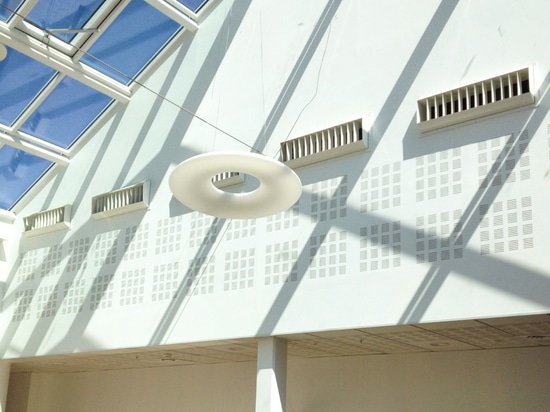
#Product Trends
The adiabatic cooling concept: a cooling solution for atriums.
An advertorial by Genatis
The atrium, radiant architectural element, is still a popular central element of a building. It spreads an optimal level of natural light, though it is prone to thermal fluctuations and summer excessive heat.
Case study of an atrium
Inside an atrium, the sun radiation will generate calorific inputs that can impact the indoor comfort and the use of a cooling system for such big volume can imply a rise of energy bill as well as non-environmentally-friendly energy consumption. However, some solutions exist ; well beyond providing answers to essential issues such as energy management and energy savings, the new brand Genatis offers a real innovation for a large array of atrium configurations, as described below.
Warm air extraction and cool air diffusion
The process of evaporating cooling (R.A.E. in French) consist of installing adiabatic cooling devices. The devices are located on the roof of the building at a certain proximity to the atrium. A main duct followed by branches will conduct the cool air flow to the one side of the building.
Each branch is connected to a long-range diffuser to cover the whole length of the atrium by creating a cool air flow just above the occupation area.
Intake air flow grids are located at the top part of the structure in order to evacuate the air where it is the warmer.
From the roof, extractors remotely controlled by the adiabatic cooling system will evacuate the warm air to the outside.
Automation and regulation
A sensor (combining temperature and humidity) will, from a threshold defined by the user, turn on/off the adiabatic cooling system and the extractors.
An outside sensor automatically activates the adiabatic cooling system. If temperature is below the threshold defined by the user, the device will operate in free-cooling mode, which mean ventilation only.
Via a 0/10-volt signal, the automation will adjust the air flow as needed. It also adjusts the extraction debit to the intake debit.
Environmental performance, comfort & savings
Unlike an air conditioning system, the calories generated by an atrium are not absorbed but evacuated to be replaced with outside air naturally cooled down. It results in reducing by 8 times the operation cost compared to an an air conditioning system, a better air quality and an optimal level of humidity.
(Source: Gérard Gaget, Adiabatic Cooling Systems Manager for the Adexsi Group)
Contact communication : Katia Schlich






